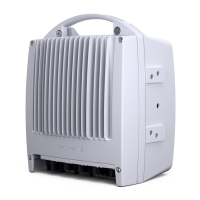MINI-LINKEandEMicro
2 Mbit/s
8 Mbit/s
O&M
10BASE-T/100BASE-TX
ALARM
34 Mbit/s
4490
Figure 52 ETU
Below follows a descr iption of the ETU main functions.
3.11.1.1 Autonegotiation
The function enables automatic configuration of duplex mode (full or half) and
Ether net traffic rate based on the configuration of the connected device, for
example a switch or a router. Autonegotiation is implemented according to
IEEE 802.3 and can be switched off to allow manual configuration.
3.11.1.2 Tr ansparency for VL AN
The ETU is transparent to Ethernet frames carrying VLAN tags, according
to IEEE 802.1Q.
The ETU is transparent to Cisco ISL encapsulated Ethernet frames of type
0000 with a maximum length of 1548 octets.
3.11.1.3 Self-learning MAC Level Bridge
The ETU has self-learning MAC level bridge functi onality, according to IEEE
802.1D, when operating at 10BASE-T. It learns the MAC addresses of all
devices in the connected LAN and does not transfer frames addressed to these
devices to the LAN at the far-end, thus avoiding unnecessary LAN-to-LAN
traffic.
3.11.1.4 Flow Control
The ETU supports flow control according to IEEE 802.3 (MAC Control PAUSE
operation). The function is used to temporarily pause transmission of traffic to a
congested device by sending out mult icast PAUSE frames.
3.11.1.5 RED Algorithm
The RED algori thm i s used to improve the performance of the ETU in case of
congestion, by randomly discarding packets when buffers are almost full. The
70
AE/LZT 110 2012 R8C 2002-03-04

